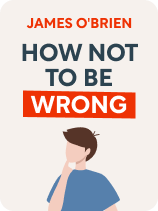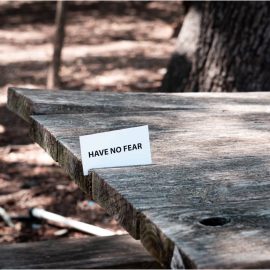

This article is an excerpt from the Shortform book guide to "How Not To Be Wrong" by James O'Brien. Shortform has the world's best summaries and analyses of books you should be reading.
Like this article? Sign up for a free trial here.
What prejudices do you have? Do you know why you have them? Can you get rid of them?
In How Not to Be Wrong: The Art of Changing Your Mind, James O’Brien examines his own misguided beliefs and ways of relating to others, concluding that life’s not all about winning the argument. It’s about recognizing our own vulnerabilities, so we can learn to have more empathy for others.
Take a look at our overview of the book and discover O’Brien’s way of changing your mind.
Overview of How Not to Be Wrong
In How Not to Be Wrong: The Art of Changing Your Mind, British broadcaster James O’Brien draws upon his personal and professional experiences to argue that in a world increasingly marked by tribalism, political division, and lack of empathy, learning to change your mind when you’re wrong is both a valuable life skill and a tool for solving intractable problems.
But his book also has a deeper message: O’Brien claims that most of our prejudices and negative attitudes toward other people stem from our denial of pain we experienced in childhood. In other words, as the saying goes, “hurt people, hurt people.” Specifically, says O’Brien, boys who are taught to deal with painful experiences by “manning up” frequently become men who believe they can fight their way out of any problem, often by attacking others.
O’Brien is one of the UK’s leading radio presenters, with over 1.2 million weekly listeners to his daily current affairs talk show. He is also the author of How to Be Right, a Sunday Times best seller that uses conversations from his show to examine how to talk to people with absurd or discriminatory opinions. As O’Brien acknowledges, he became well known as a radio host for “schooling” his guests—using verbal aggression to win arguments at any cost.
Relying in part on transcripts from his radio show, O’Brien examines his mistaken beliefs and prejudices in turn and highlights times when his listeners opened his eyes to a new perspective. In this guide, we divide O’Brien’s “wrong” beliefs into two parts, first examining his beliefs about himself and then taking a look at his beliefs about other people. A third section examines O’Brien’s conclusion that denial of our own pain causes us to lack empathy for others’ pain.
Beliefs About Self
O’Brien was in his forties when he began questioning some of the beliefs he’d held for years. For much of his life, O’Brien was the guy who always had to be right and could never back down from arguing his position. He was afraid that being wrong would make him weak or vulnerable. Therapy helped O’Brien realize that negative experiences in his childhood shaped who he was as an adult.
He began to see that he was living in an almost permanent “fight or flight” state of hyperarousal, which caused him to think he could fight his way out of any problem. He understood that he needed to come to terms with how he had been wrong about himself and other people and that, to do so, he needed to question the source of those beliefs.
O’Brien, who was adopted, was sent to an all-boys boarding school, where the headmaster regularly beat him for years. O’Brien always defended the practice by saying that he turned out OK. He didn’t believe he was harmed by it. In fact, he frequently bragged about the beatings, treating the experience as a badge of honor that demonstrated his toughness. The truth is that O’Brien was in denial about how much pain and humiliation the beatings had caused him. In response, he developed what he calls a “survival personality” to protect himself, and it became the basis for his success. In the process, however, he abandoned his true self.
O’Brien’s views first began to shift when he was a contributor on a TV show and was defending the practice of spanking children. A participant asked him whether he would hit his wife if she disobeyed him. He realized that as a question of basic humanity, it’s never acceptable to physically harm another person to discipline or punish them, regardless of their age.
The corporal punishment inflicted on O’Brien in childhood primed him to constantly be on the alert for attack, so, as an adult, even small issues caused him to overreact. Aggression became a way of life. He extrapolates from his own experiences that our early, unconscious defense mechanisms can become our entire personality and way of relating to the world.
O’Brien believes that much of public debate today is between people who have built up so much armor to protect themselves from past pain that they are essentially showing the world a false persona. It’s difficult for people to truly listen to each other and learn more about controversial issues when they aren’t even showing up as their authentic selves. By examining our negative childhood experiences, we can learn to change our minds and bridge the gap between opposing viewpoints.
Beliefs About Others
In addition to examining his beliefs about himself, therapy led O’Brien to examine his beliefs about others. Specifically, he recognized that, despite his progressive politics, he had been blind to systemic inequity that didn’t affect him directly, and he held unfounded prejudices against certain groups of people.
Failure to Recognize Racism and White Privilege
O’Brien claims that he wasn’t exposed to racism growing up, because (according to him) his friends who were people of color didn’t experience it in school. Since he didn’t observe racism around him in his boarding school or college, he didn’t think it was a problem.
As an adult, he didn’t view the law enforcement practice of indiscriminate stop and search (stop-and-frisk in America) as an example of racial profiling. The more he listened to people with negative experiences of stop-and-frisk, the harder it became to hold on to his opinions. O’Brien says that, if he had been in another job where he wasn’t exposed to those opinions, he might never have changed his mind.
He realized that his views on stop-and-frisk had been another version of his belief that pain makes you stronger, and that the best way to approach unfair punishment is to grit your teeth and accept it. Coming to terms with his own childhood pain helped O’Brien empathize with and change his mind about other people.
Just as O’Brien didn’t recognize race as a factor in stop-and-frisk policing, he also failed to see his own race as a factor in his success. One of O’Brien’s callers made him see white privilege differently. The caller talked about representation in film and media and said that even O’Brien’s radio station had only one presenter who was a person of color. He came to believe that white people see themselves reflected and represented in the media in a way that people of color don’t, and that gives them a head start.
Prejudices Against Overweight People, People With Tattoos, and Unmarried People
O’Brien recognized that some of his beliefs about others were unfair and unfounded. Examining the source of prejudices and talking to callers on his radio show helped him change his mind about overweight people, people with tattoos, and unmarried people.
“Fat-Shaming” and Prejudice Against Overweight People
O’Brien used to bully fat people on his radio show, even though he himself was overweight. O’Brien analyzes his own “othering” of fat people to demonstrate how he uses the same tactics as anyone who tries to dehumanize a group of people:
- He focused on criticizing a government program designed to reward overweight people financially if they lost weight. In this way, he gave people a reason to get angry that resources that belonged to them—in this case, taxpayer money—were being “unfairly” redistributed to other people.
- He used terms that compared human beings to inanimate objects. This made it easier for listeners not to have to think of fat people as real humans with feelings.
- He argued that the money being spent to encourage people to lose weight could have been spent to provide terminally ill people with medication. This allowed people to think that they weren’t attacking fat people; rather, they were protecting terminally ill people.
- He emphasized the seriousness of the threat posed by obese people taking taxpayer money.
O’Brien’s prejudice against fat people began to change when his family hired a wonderful person to help with childcare. She had long struggled with her weight (and she listened to his show). Knowing that she was a listener, every time he was about to launch into a diatribe about fat people, he thought of her.
He also realized that his criticism of others was more about his own inability to lose weight. It was another example of his “survival personality” refusing to admit that he was vulnerable and needed help.
Prejudice Against People With Tattoos & Unmarried People
O’Brien tried to figure out why he felt the way he did about tattoos, and he remembered an early scary experience with a mentally ill man from his town who had a spiderweb tattooed over his whole face. O’Brien realized that holding onto a strong opinion about tattoos helped him feel a sense of control and order in a chaotic world. It was a type of false certainty used to combat fear (not unlike religion, he says).
On the marriage question, O’Brien realized that he held this belief because his parents told him that his biological mom (a single woman) gave him up for adoption because she thought his adoptive parents could give him a better life than she ever could. He took this to mean that a “better life” was what married people experienced. It was hard for him to let go of this belief because the importance of marriage was tied up with his own “origin story.”
Letting Go of Prejudices (Changing Your Mind)
O’Brien lets go of his prejudices by asking himself tough questions about why he believes what he does. He believes that you can’t argue someone into changing their mind; you can only ask them questions until they get to a place where they might change their own mind.
In examining “wrong” beliefs and prejudices, whether they’re his own or someone else’s, O’Brien typically asks the following questions:
- What are you afraid of?
- What are you really angry about?
- How would you feel if the roles were reversed?
In considering everything he had been wrong about, O’Brien wonders whether the source of his wrongness on less important issues was the same as the source of his wrongness on significant issues. He concludes that the source is the same: childhood trauma.
O’Brien says that our lack of empathy and negative attitudes about other people almost always stem from our denial of our own pain. As long as we fail to address the negative experiences that made us who we are, it will be hard for us to understand the perspectives of others. However, if we can recognize our own hurt, we can let down our guard and be more vulnerable, which allows us to relate to others by listening and establishing trust, rather than by arguing.
And by listening and learning, we can change our minds.
Exercise: Question Your Prejudices
O’Brien calls his book How Not to Be Wrong, but it could just as easily be called “How Not to Be Prejudiced,” as most of what O’Brien says he was wrong about are his negative attitudes toward groups of people. It takes courage to acknowledge your own prejudices, but doing so can be the first step toward combating them—and getting to the root of why you feel the way you do.
- Everyone has prejudices. However illogical or unfounded your opinions on a particular group of people may be, describe your thoughts and feelings about this group.
- Using the questions O’Brien asks to get at the root of his negative feelings toward others, ask yourself: (1) What are you afraid of? (2) What are you really angry about? (3) How would you feel if the roles were reversed? Before answering these questions, take a moment to consider how negative experiences in your childhood may be affecting the prejudices you hold in the present.
- Do you believe that your childhood experiences shaped your feelings about this group? If yes, how so?

———End of Preview———
Like what you just read? Read the rest of the world's best book summary and analysis of James O'Brien's "How Not To Be Wrong" at Shortform.
Here's what you'll find in our full How Not To Be Wrong summary:
- Why learning to change your mind is a valuable skill
- How to combat prejudice and gain empathy for others
- Why you should take a step back and reexamine your beliefs






